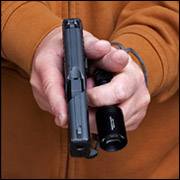Not sure if this has been posted here before, but here's the link;
https://www.greeneyetactical.com/201...ight-parallax/
Cliff Notes Version
Red Dot Sights have been promoted as "parallax free" by just about every RDS manufacturer. The big deal about this is the idea that as long as you place the dot on the target, it makes no difference where the dot appears in the optic. As long as you can see the dot somewhere in the optic and place it on the target, you're good to go. It turns out that this claim is largely buffalo bagels.
As someone who enjoys good gun porn (many really excellent photogs out there), I've noticed a trend of rifles equipped with a RDS also sporting a fixed front sight post, mostly in combination with a folding rear. It wasn't until I read the study (link above) that it made sense, confirmed by comments on this topic on MC4: using the front sight post to achieve repeatable dot location in the field of view for maximum accuracy by minimizing the hellacious parallax some well known, top-tier brands of RDS suffer from.
Maybe I'm out-of-touch with the current carbine sighting-system group-think, but I certainly feel better informed now. I also don't feel as bad now running irons only. :-)




 Reply With Quote
Reply With Quote



